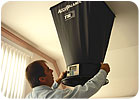Another concern was making sure that the system delivered the efficiency its customers were paying for.

MOVING TO THE ATTIC
"We have moved many closet units to the attic, sometimes with a very tight space," said Wayne Mulholland of Tri County Mechanical, Azle and Fort Worth, Texas. "Inspectors hate us for this. We also have a remodeling contractor to assist us."In one case, the company did an a/c retrofit for a house in Lake Worth, a suburb of Fort Worth. "This house is 103 years old," Mulholland said, "built out of stone that came from the riverbed. It has been added onto three or four times." The original part of the house, built in 1903, consisted of one room, he said. A 1910 remodel added one more room. A 1930 addition created what is now the rest of the house. The old furnace was installed in a closet.
As has been the case for a lot of contractors, Tri County Mechanical has been installing a lot of new furnaces in order to make room for the indoor a/c coils.
In this case, the contractor found that there was enough room to put the gas furnace in the attic. "Young lady," he asked the owner, "how would you like another clothes closet?" The thrilled homeowner approved the installation of a 23 1/2-inch-wide, variable-speed furnace in the attic. This required the installation of a drop-down staircase in a back room, which was carried out by "Sheet Rock Duncan." (Duncan, who has been subcontracted for most of Tri County's remodeling work, also finished the closet the furnace was removed from.)
In downtown Fort Worth, the contractor installed a new furnace in the attic of a 1940s house. "Putting a new unit in the closet would never fit," he said. "The closet was only 13 inches wide." In still other cases, "People were complaining about the noise of the old unit, or they wanted to add AccuClean [an air filtration system], or wanted to add a nice filter base. And, we wanted to be able to work on it when it's installed. In a closet, there's no way we're going to be able to open the door and work on the electricals."
Once the contractor has decided to move the air handler into the attic, "everything's got to go," Mulholland said. There is no room for quibbling with the customer. "We're there because there is a problem. If we can put it in the attic, it's much more beneficial for them and for us, though if it's a low-pitched roof, we usually are on our knees to work on the unit. "That's why the inspectors hate us; they're on their knees to inspect the ductwork!"

FIXING THE DUCTWORK
In Virginia, the problem of making the system fit isn't quite as complicated. "We try to locate equipment to minimize the modifications to the supply-side ductwork," said James Kester, Colonial Plumbing and Heating Co., Colonial Heights. "Usually there is room for the coil to be placed in its original location."Airflow is critical for the new high-efficiency systems," he said. "We are spending more time evaluating the duct system before quoting equipment replacement."
The company has been spending more time "actually educating the customer that the equipment now is more efficient but there are caveats in loss of air through the duct system," he said. "If you're really interested in efficiency, you need to evaluate the duct system."
According to Kester, more than one-half of the systems he works on have sheet metal ductwork. "In the homes we're seeing, fiber duct is not predominant. A good portion of the homes that are 10 to 20 years old use metal."
It's said that 100 percent of sheet metal ducts leak. "I don't think we ever find less than 20 percent leakage," Kester said. "It's a good amount of air leaking around the system. Until five or six years ago, we never saw a system that had duct sealant on it."

Leaky ductwork robs a new system of its efficiency, Kester said. "It's wasting all of the cooling going up in that attic.
"If the duct is not repaired, it's more than just performance reductions," he added. "There are lifespan reductions and immediate service problems. When we first put in the higher-efficiency systems, if we didn't tell the homeowner that they needed better duct, we'd be going back for the next two years on unnecessary service calls."
Colonial does its own pressure testing. "We use that big blue box for an airflow hood," Kester said. "We do the static pressure test with the wand. We check cfm at every diffuser, and check the loss that way.
"We started doing airflow testing during the fourth quarter of last year," he said. "We used a third party for the first three or four months, just to see if we should get our own equipment." The company bought its own equipment about nine months ago. "I think it's paid off already, and built some real good customer relations," Kester said. "We're differentiating ourselves from the other two or three people who walk through the customer's door."
Publication date: 11/27/2006

Report Abusive Comment